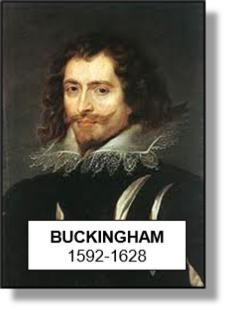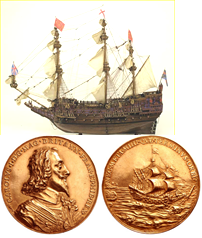


xxxxxCharles I, a firm believer in the Divine Right of Kings and in favour of the High Church of England, was soon in trouble with Parliament. Its members refused to grant him money and, in March 1628, when the country was at war with both France and Spain, they accused him of illegal taxation and drew up a Petition of Rights. This claimed that there could be no taxation without the consent of Parliament, and no imprisonment without just cause. Eventually in March 1629 the king dismissed Parliament and took over the government of the country. The years that followed came to be known as the Eleven Years’ Tyranny but, in fact, with the end of the war with France and Spain, trade flourished and the nation prospered. Nonetheless he was still short of funds, and his tax, the so-
THE "ELEVEN YEARS' TYRANNY" 1629 -
Acknowledgement
Buckingham: by the Flemish painter Peter Paul Rubens (1577-
xxxxxAs his father had warned him, from the very beginning of his reign Charles had trouble with Parliament. Apart from his belief in the Divine Right of Kings, his sympathies lay with the High Church of England whereas the majority of Parliamentarians were Puritans, with no time for the prayer book, rule by bishops, or elaborate ritual in the conduct of services. The first parliament, called in June 1625, also opposed the continuation in office of the Duke of Buckingham, a man already distrusted for his influence over James I. As a consequence the Commons refused to grant the king the right to levy customs duties, a lucrative source of income and one which had been granted to his predecessors for life.
 xxxxxThe second parliament of February 1626 lasted about four months. Alarmed at Buckingham's disastrous failure in his attack upon the Spanish port of Cadiz, its members attempted to put him on trial for treason. Charles would have none of it, and parliament was dissolved. By the time his third parliament assembled in March 1628, called to provide much-
xxxxxThe second parliament of February 1626 lasted about four months. Alarmed at Buckingham's disastrous failure in his attack upon the Spanish port of Cadiz, its members attempted to put him on trial for treason. Charles would have none of it, and parliament was dissolved. By the time his third parliament assembled in March 1628, called to provide much-
xxxxxThe fourth parliament was convened in January 1629, and the wrangling continued. Its members renewed their protests against the king, objecting to the revival of "popish practices" in the Church of England (the Queen was a Roman Catholic), and once again condemning illegal taxation -
 xxxxxSurprisingly enough, the "Eleven Years' Tyranny" which followed were comparatively successful as far as the country was concerned. Charles made peace with France and Spain, and the country's expanding trade substantially boosted his income from customs duties. He even tried to economise in the matter of court expenditure. But not all was sweet and light. He ran foul of public opinion in 1634 with his introduction of "ship money" to pay for the cost of the Royal Navy. Levied first on ports and then later on inland towns, it aroused widespread opposition, led by the prominent member of Parliament John Hampden. In 1638 the judges serving in the Court of the Exchequer supported the Crown, but the majority was so narrow that the protest continued unabated. Furthermore, the increasing role being played in the affairs of state by the king's wife, the Roman Catholic Henrietta Maria -
xxxxxSurprisingly enough, the "Eleven Years' Tyranny" which followed were comparatively successful as far as the country was concerned. Charles made peace with France and Spain, and the country's expanding trade substantially boosted his income from customs duties. He even tried to economise in the matter of court expenditure. But not all was sweet and light. He ran foul of public opinion in 1634 with his introduction of "ship money" to pay for the cost of the Royal Navy. Levied first on ports and then later on inland towns, it aroused widespread opposition, led by the prominent member of Parliament John Hampden. In 1638 the judges serving in the Court of the Exchequer supported the Crown, but the majority was so narrow that the protest continued unabated. Furthermore, the increasing role being played in the affairs of state by the king's wife, the Roman Catholic Henrietta Maria -

xxxxxBut, as we shall see, this somewhat benevolent dictatorship -
C1-


